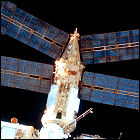 For the first time in five years, and the first time under the auspices of the Russian Federation, a new module is launched to expand the Mir space station. Originally devised as an add-on compartment to house experiments and equipment of a military nature, the Spektr module is, somewhat ironically, refitted to house American astronauts who will be joining future Mir station crews. Spektr also doubles Mir’s power generating capacity with its own solar panels.
For the first time in five years, and the first time under the auspices of the Russian Federation, a new module is launched to expand the Mir space station. Originally devised as an add-on compartment to house experiments and equipment of a military nature, the Spektr module is, somewhat ironically, refitted to house American astronauts who will be joining future Mir station crews. Spektr also doubles Mir’s power generating capacity with its own solar panels.

 Space Shuttle Atlantis lifts off on an almost-ten-day mission to dock with the Russian space station Mir. The first docking proves to be a chore, as the Mir crew has to move one of the station’s modules to a different docking port to accomodate the shuttle. The historic docking – the first joint operation between the two countries since the Apollo-Soyuz mission almost exactly 20 years earlier – results in the largest man-made object in space to date. Aboard Atlantis are Commander Robert Gibson, Pilot Charles Precourt, and mission specialists Ellen Baker, Bonnie Dunbar and Gregory Harbaugh; cosmonauts Anatoly Solovyev and Nikolai Budarin are transported to Mir aboard Atlantis to become part of Mir Expedition 19, while Expedition 18 crew members Norman Thagard, Vladimir Dezhurov and Gannady Strekalov return to Earth after more than three months aboard Mir.
Space Shuttle Atlantis lifts off on an almost-ten-day mission to dock with the Russian space station Mir. The first docking proves to be a chore, as the Mir crew has to move one of the station’s modules to a different docking port to accomodate the shuttle. The historic docking – the first joint operation between the two countries since the Apollo-Soyuz mission almost exactly 20 years earlier – results in the largest man-made object in space to date. Aboard Atlantis are Commander Robert Gibson, Pilot Charles Precourt, and mission specialists Ellen Baker, Bonnie Dunbar and Gregory Harbaugh; cosmonauts Anatoly Solovyev and Nikolai Budarin are transported to Mir aboard Atlantis to become part of Mir Expedition 19, while Expedition 18 crew members Norman Thagard, Vladimir Dezhurov and Gannady Strekalov return to Earth after more than three months aboard Mir. Ron Howard’s
Ron Howard’s 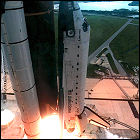 Space Shuttle Discovery lifts off on the 70th shuttle flight, a nine-day mission to deploy a TDRS (Tracking & Data Relay Satellite) for NASA. The flight has seen many delays, including repairs made necessary by woodpeckers poking holes in the shuttle’s external fuel tank! The crew – consisting of Commander Terence Henricks, Pilot Kevin Kregel, and mission specialists Nancy Jane Currie, Donald Thomas and Mary Ellen Weber – conducts material and medical experiments after the deployment of the final satellite in the TDRS constellation.
Space Shuttle Discovery lifts off on the 70th shuttle flight, a nine-day mission to deploy a TDRS (Tracking & Data Relay Satellite) for NASA. The flight has seen many delays, including repairs made necessary by woodpeckers poking holes in the shuttle’s external fuel tank! The crew – consisting of Commander Terence Henricks, Pilot Kevin Kregel, and mission specialists Nancy Jane Currie, Donald Thomas and Mary Ellen Weber – conducts material and medical experiments after the deployment of the final satellite in the TDRS constellation.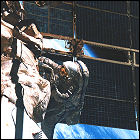 Russia launches the Soyuz TM-22 mission to space station Mir, carrying cosmonauts Yuri Gidzenko and Sergei Avdeyev from Russia, and Thomas Reiter from Germany. The three space travelers settle in for a 179-day stay aboard Mir, from which they will return early in 1996.
Russia launches the Soyuz TM-22 mission to space station Mir, carrying cosmonauts Yuri Gidzenko and Sergei Avdeyev from Russia, and Thomas Reiter from Germany. The three space travelers settle in for a 179-day stay aboard Mir, from which they will return early in 1996.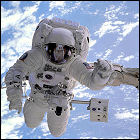 Space Shuttle Endeavour lifts off on the 71st shuttle flight, an 11-day mission to conduct solar wind experiments and test out new spacewalking techniques and space suit revisions for future construction of the International Space Station. Aboard Endeavour for her ninth flight are Commander David Walker, Pilot Kenneth Cockrell, Payload Commander James Voss, and mission specialists James Newman and Michael Gernhardt.
Space Shuttle Endeavour lifts off on the 71st shuttle flight, an 11-day mission to conduct solar wind experiments and test out new spacewalking techniques and space suit revisions for future construction of the International Space Station. Aboard Endeavour for her ninth flight are Commander David Walker, Pilot Kenneth Cockrell, Payload Commander James Voss, and mission specialists James Newman and Michael Gernhardt.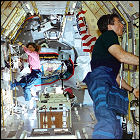 Space Shuttle Columbia is launched on the 72nd shuttle mission, and Columbia’s 18th visit to Earth orbit. Over a 16-day period, the Spacelab module mounted in the cargo bay hosts the second U.S. Microgravity Laboratory mission, with experiments conducted around the clock. The first pitch of the fifth game of the 1995 World Series is thrown aboard Columbia and broadcast live – the first time that the first pitch of a game took place somewhere other than the ballpark in question. Columbia is manned by Commander Kenneth Bowersox, Pilot Kent Rominger, Payload Commander Kathryn Thornton, mission specialists Catherine Coleman and Michael Lopez-Alegria, and payload specialists Fred Leslie and Albert Sacco.
Space Shuttle Columbia is launched on the 72nd shuttle mission, and Columbia’s 18th visit to Earth orbit. Over a 16-day period, the Spacelab module mounted in the cargo bay hosts the second U.S. Microgravity Laboratory mission, with experiments conducted around the clock. The first pitch of the fifth game of the 1995 World Series is thrown aboard Columbia and broadcast live – the first time that the first pitch of a game took place somewhere other than the ballpark in question. Columbia is manned by Commander Kenneth Bowersox, Pilot Kent Rominger, Payload Commander Kathryn Thornton, mission specialists Catherine Coleman and Michael Lopez-Alegria, and payload specialists Fred Leslie and Albert Sacco.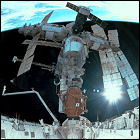 NASA launches Space Shuttle Atlantis on the 73rd shuttle flight, an eight-day mission to dock with Russian space station Mir. Due to the docking difficulties of the first flight – which required Mir crew members to move one of their station’s modules out of the shuttle’s way temporarily – Atlantis carries a Russian-made docking adapter which adds a tunnel to one of Mir’s docking ports, allowing the shuttle to join up with the station without further module relocation. Atlantis carries Commander Kenneth Cameron, Pilot James Halsell, and mission specialists Jerry Ross, William McArthur and Chris Hadfield to visit Mir; there is no crew exchange on this flight.
NASA launches Space Shuttle Atlantis on the 73rd shuttle flight, an eight-day mission to dock with Russian space station Mir. Due to the docking difficulties of the first flight – which required Mir crew members to move one of their station’s modules out of the shuttle’s way temporarily – Atlantis carries a Russian-made docking adapter which adds a tunnel to one of Mir’s docking ports, allowing the shuttle to join up with the station without further module relocation. Atlantis carries Commander Kenneth Cameron, Pilot James Halsell, and mission specialists Jerry Ross, William McArthur and Chris Hadfield to visit Mir; there is no crew exchange on this flight. Space Shuttle Endeavour lifts off on the 74th flight of the shuttle program. Over nine days, Endeavour’s crew retrieves a Japanese satellite for return to Earth while deploying a NASA experiment which flies as far as 45 miles away from the shuttle for two days before it, too, is retrieved. More spacewalk techniques and technologies are tried out for future space station construction. Aboard Endeavour for her tenth flight are Commander Brian Duffy, Pilot Brent Jett, and mission specialists Leroy Chiao, Daniel Barry, Winston Scott and Koichi Wakata.
Space Shuttle Endeavour lifts off on the 74th flight of the shuttle program. Over nine days, Endeavour’s crew retrieves a Japanese satellite for return to Earth while deploying a NASA experiment which flies as far as 45 miles away from the shuttle for two days before it, too, is retrieved. More spacewalk techniques and technologies are tried out for future space station construction. Aboard Endeavour for her tenth flight are Commander Brian Duffy, Pilot Brent Jett, and mission specialists Leroy Chiao, Daniel Barry, Winston Scott and Koichi Wakata.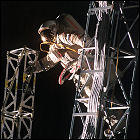 Russia launches the Soyuz TM-23 mission to the Mir space station. The crew, cosmonauts Yuri Onufrienko and Yury Usachov, remain aboard Mir for 193 days, returning to Earth in September 1996 with French spationaut Claudie André-Deshays.
Russia launches the Soyuz TM-23 mission to the Mir space station. The crew, cosmonauts Yuri Onufrienko and Yury Usachov, remain aboard Mir for 193 days, returning to Earth in September 1996 with French spationaut Claudie André-Deshays.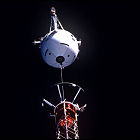 Space Shuttle Columbia is launched on the 75th shuttle flight, staying in orbit for nearly 16 days. The crew attempts to deploy a tethered satellite experiment flown unsuccessfully in 1992, only to watch as the tether snaps with the satellite 12 miles away from the shuttle. The remainder of the flight is spent conducting planned material science experiments. Aboard Columbia for her 19th flight are Commander Andrew Allen, Pilot Scott Horowitz, Payload Commander Franklin Chang-Diaz, and mission specialists Maurizio Cheli, Jeffrey Hoffman, Claude Nicollier and Umberto Guidoni. To this day, video of the satellite floating in space after the tether failure is circulated as “proof” of the existence of UFOs.
Space Shuttle Columbia is launched on the 75th shuttle flight, staying in orbit for nearly 16 days. The crew attempts to deploy a tethered satellite experiment flown unsuccessfully in 1992, only to watch as the tether snaps with the satellite 12 miles away from the shuttle. The remainder of the flight is spent conducting planned material science experiments. Aboard Columbia for her 19th flight are Commander Andrew Allen, Pilot Scott Horowitz, Payload Commander Franklin Chang-Diaz, and mission specialists Maurizio Cheli, Jeffrey Hoffman, Claude Nicollier and Umberto Guidoni. To this day, video of the satellite floating in space after the tether failure is circulated as “proof” of the existence of UFOs.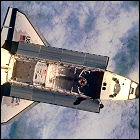 Space Shuttle Atlantis lifts off on the 76th shuttle mission, a flight to dock with the Russian space station Mir. Supplies are delivered to Mir by the Atlantis crew, and astronaut Shannon Lucid remains aboard Mir to join its Expedition 21 crew. Atlantis also carries the SPACEHAB module, where both the shuttle and station crews conduct joint scientific experiments. Aboard Atlantis for her 16th flight are Commander Kevin Chilton, Pilot Richard Searfoss, and mission specialists Shannon Lucid, Linda Godwin, Michael Clifford and Ronald Sega.
Space Shuttle Atlantis lifts off on the 76th shuttle mission, a flight to dock with the Russian space station Mir. Supplies are delivered to Mir by the Atlantis crew, and astronaut Shannon Lucid remains aboard Mir to join its Expedition 21 crew. Atlantis also carries the SPACEHAB module, where both the shuttle and station crews conduct joint scientific experiments. Aboard Atlantis for her 16th flight are Commander Kevin Chilton, Pilot Richard Searfoss, and mission specialists Shannon Lucid, Linda Godwin, Michael Clifford and Ronald Sega.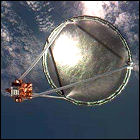 Space Shuttle Endeavour lifts off on the 77th shuttle mission, a ten-day flight to perform experiments in the cargo-bay-mounted SPACEHAB module, and a test of a free-flying inflatible antenna system. The crew also communicates with astronaut Shannon Lucid aboard Mir, though Endeavour and Mir are in different orbits. Aboard Endeavour for her 11th flight are Commander John Casper, Pilot Curtis Brown, and mission specialists Daniel Bursch, Mario Runco, Marc Garneau and Andrew Thomas.
Space Shuttle Endeavour lifts off on the 77th shuttle mission, a ten-day flight to perform experiments in the cargo-bay-mounted SPACEHAB module, and a test of a free-flying inflatible antenna system. The crew also communicates with astronaut Shannon Lucid aboard Mir, though Endeavour and Mir are in different orbits. Aboard Endeavour for her 11th flight are Commander John Casper, Pilot Curtis Brown, and mission specialists Daniel Bursch, Mario Runco, Marc Garneau and Andrew Thomas.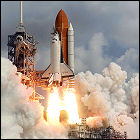 Space Shuttle Columbia lifts off on the 78th shuttle mission, a Spacelab flight lasting nearly 17 days and devoted to the effects of microgravity on various forms of life. The crew also tests maneuvers under consideration for a future Hubble Space Telescope servicing mission which could safely boost Hubble’s orbit without damaging it. Aboard Columbia for her 20th flight are Commander Terence Henricks, Pilot Kevin Kregel, flight engineer Susan Helms, mission specialists Richard Linnehan and Charles Brady, and payload specialists Jean-Jacques Favier and Robert Thirsk.
Space Shuttle Columbia lifts off on the 78th shuttle mission, a Spacelab flight lasting nearly 17 days and devoted to the effects of microgravity on various forms of life. The crew also tests maneuvers under consideration for a future Hubble Space Telescope servicing mission which could safely boost Hubble’s orbit without damaging it. Aboard Columbia for her 20th flight are Commander Terence Henricks, Pilot Kevin Kregel, flight engineer Susan Helms, mission specialists Richard Linnehan and Charles Brady, and payload specialists Jean-Jacques Favier and Robert Thirsk. Soyuz TM-24 is launched from Russia, on a mission to dock with the Mir space station. Aboard are cosmonauts Valery Korzun and Aleksandr Kaleri, who stay aboard Mir for 196 days, and visiting French spationaut Claudie André-Deshays, the first French woman in space, who stays aboard Mir for 16 days before returning to Earth with the station’s previous crew aboard Soyuz TM-23. Korzun and Kaleri will return to Earth in March 1997.
Soyuz TM-24 is launched from Russia, on a mission to dock with the Mir space station. Aboard are cosmonauts Valery Korzun and Aleksandr Kaleri, who stay aboard Mir for 196 days, and visiting French spationaut Claudie André-Deshays, the first French woman in space, who stays aboard Mir for 16 days before returning to Earth with the station’s previous crew aboard Soyuz TM-23. Korzun and Kaleri will return to Earth in March 1997.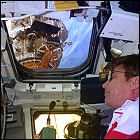 After multiple delays, including the entire launch stack having to be rolled back into the safety of the Vehicle Assembly Building to protect it from two back-to-back hurricanes, Space Shuttle Atlantis lifts off on the fourth mission to dock with the Russian Mir space station. Supplies are transferred to Mir, and numerous completed science experiments from Mir are loaded into the shuttle. Atlantis is flown by Commander William Readdy, Pilot Terrence Wilcutt, and mission specialists Thomas Akers, John Blaha, Jay Apt and Carl Walz. Blaha remains on Mir, taking the place of American astronaut Shannon Lucid, who has just set a new American space endurance record of 188 days in orbit; Lucid returns to Earth with the Atlantis crew.
After multiple delays, including the entire launch stack having to be rolled back into the safety of the Vehicle Assembly Building to protect it from two back-to-back hurricanes, Space Shuttle Atlantis lifts off on the fourth mission to dock with the Russian Mir space station. Supplies are transferred to Mir, and numerous completed science experiments from Mir are loaded into the shuttle. Atlantis is flown by Commander William Readdy, Pilot Terrence Wilcutt, and mission specialists Thomas Akers, John Blaha, Jay Apt and Carl Walz. Blaha remains on Mir, taking the place of American astronaut Shannon Lucid, who has just set a new American space endurance record of 188 days in orbit; Lucid returns to Earth with the Atlantis crew. Space Shuttle Columbia lifts off on the 80th shuttle flight, a science mission lasting nearly 18 days. Two free-floating experiment platforms are deployed and then retrieved by the end of the mission for delivery back to Earth. Two spacewalks to test space station construction techniques are called off for safety reasons when a problem arises with Columbia’s airlock. Aboard Columbia for her 21st flight are Commander Kenneth Cockrell, Pilot Kent Rominger, and mission specialists Tammy Jernigan, Thomas Jones and Story Musgrave.
Space Shuttle Columbia lifts off on the 80th shuttle flight, a science mission lasting nearly 18 days. Two free-floating experiment platforms are deployed and then retrieved by the end of the mission for delivery back to Earth. Two spacewalks to test space station construction techniques are called off for safety reasons when a problem arises with Columbia’s airlock. Aboard Columbia for her 21st flight are Commander Kenneth Cockrell, Pilot Kent Rominger, and mission specialists Tammy Jernigan, Thomas Jones and Story Musgrave.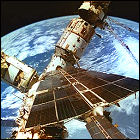 Space Shuttle Atlantis lifts off on the 81st shuttle flight, a ten-day mission featuring the fifth docking between Atlantis and the Mir space station. Atlantis again carries the SPACEHAB module in its cargo bay, and thousands of pounds of consumables and equipment are transferred from the shuttle to Mir. Aboard Atlantis for her 17th flight are Commander Michael Baker, Pilot Brent Jett, and mission specialists John Grunsfeld, Marsha Ivins, Peter Wisoff and Jerry Linenger. Linenger remains on Mir, while American Mir Expedition 22 crewmember John Blaha returns after 128 days in space.
Space Shuttle Atlantis lifts off on the 81st shuttle flight, a ten-day mission featuring the fifth docking between Atlantis and the Mir space station. Atlantis again carries the SPACEHAB module in its cargo bay, and thousands of pounds of consumables and equipment are transferred from the shuttle to Mir. Aboard Atlantis for her 17th flight are Commander Michael Baker, Pilot Brent Jett, and mission specialists John Grunsfeld, Marsha Ivins, Peter Wisoff and Jerry Linenger. Linenger remains on Mir, while American Mir Expedition 22 crewmember John Blaha returns after 128 days in space. Russian cosmonauts Vasili Tsibliyev and Aleksandr Lazutkin lift off aboard Soyuz TM-25 for an eventful mission aboard Russian space station Mir. Tagging along is German space traveler Reinhold Ewald, who will remain in space for 19 days before returning to Earth with Mir’s previous crew aboard Soyuz TM-24; Tsibliyev and Lazutkin will later be joined by American shuttle astronaut Jerry Linenger. Their 184-day stay is marred by numerous emergencies aboard the station, ranging from a fire in the station’s cramped quarters to a collision with an unmanned Progress cargo spacecraft, which Russian ground controllers are initially eager to keep quiet from the rest of the world.
Russian cosmonauts Vasili Tsibliyev and Aleksandr Lazutkin lift off aboard Soyuz TM-25 for an eventful mission aboard Russian space station Mir. Tagging along is German space traveler Reinhold Ewald, who will remain in space for 19 days before returning to Earth with Mir’s previous crew aboard Soyuz TM-24; Tsibliyev and Lazutkin will later be joined by American shuttle astronaut Jerry Linenger. Their 184-day stay is marred by numerous emergencies aboard the station, ranging from a fire in the station’s cramped quarters to a collision with an unmanned Progress cargo spacecraft, which Russian ground controllers are initially eager to keep quiet from the rest of the world.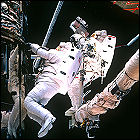 Space Shuttle Discovery lifts off on a ten-day mission to service the Hubble Space Telescope. Over 30 hours of spacewalks are conducted to repair and upgrade Hubble with new parts, and the shuttle engines are fired in short, steady bursts to raise the telescope’s orbit by over eight miles before it is released again. Aboard Discovery on her 22nd flight are Commander Kenneth Bowersox, Pilot Scott Horowitz, and mission specialists Mark Lee, Steven Hawley, Gregory Harbaugh, Steven Smith and Joseph Tanner.
Space Shuttle Discovery lifts off on a ten-day mission to service the Hubble Space Telescope. Over 30 hours of spacewalks are conducted to repair and upgrade Hubble with new parts, and the shuttle engines are fired in short, steady bursts to raise the telescope’s orbit by over eight miles before it is released again. Aboard Discovery on her 22nd flight are Commander Kenneth Bowersox, Pilot Scott Horowitz, and mission specialists Mark Lee, Steven Hawley, Gregory Harbaugh, Steven Smith and Joseph Tanner. Fire breaks out aboard the Russian space station Mir, forcing the crew to break out face masks and goggles which they must keep on even after the fire is put out. The culprit is determined to be an oxygen generator, which is damaged beyond repair; fortunately, American crewmember Jerry Linenger is a medical doctor and determines that he and his crewmates are none the worse for wear. A new oxygen generator will arrive on the next Space Shuttle mission to Mir later in the year.
Fire breaks out aboard the Russian space station Mir, forcing the crew to break out face masks and goggles which they must keep on even after the fire is put out. The culprit is determined to be an oxygen generator, which is damaged beyond repair; fortunately, American crewmember Jerry Linenger is a medical doctor and determines that he and his crewmates are none the worse for wear. A new oxygen generator will arrive on the next Space Shuttle mission to Mir later in the year. Crew members of space station Mir and Russian ground controllers practice manual remote control of an unmanned Progress supply vehicle near the station. Where most previous Progress spacecraft have automatically docked using the KURS radar system, Russia is now seeking alternatives, as the Ukraine-made KURS hardware is proving too expensive to keep buying for non-reusable vehicles. During Mir Commander Vasily Tsibliev’s attempt to redock Progress M33, the remote control signal is interrupted, leaving the ten-ton Progress barreling toward the station. Fortunately, it narrowly misses Mir, though the remote control issue will resurface more dramatically with the next Progress craft to visit the space station.
Crew members of space station Mir and Russian ground controllers practice manual remote control of an unmanned Progress supply vehicle near the station. Where most previous Progress spacecraft have automatically docked using the KURS radar system, Russia is now seeking alternatives, as the Ukraine-made KURS hardware is proving too expensive to keep buying for non-reusable vehicles. During Mir Commander Vasily Tsibliev’s attempt to redock Progress M33, the remote control signal is interrupted, leaving the ten-ton Progress barreling toward the station. Fortunately, it narrowly misses Mir, though the remote control issue will resurface more dramatically with the next Progress craft to visit the space station.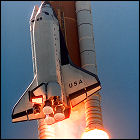 Space Shuttle Columbia is launched on the 83rd shuttle mission, intended to last over two weeks. In the cargo bay, the Spacelab module is set up for an intensive study of the behavior of natural processes in microgravity. A recurring issue with one of the shuttle’s three fuel cells concerns ground controllers enough to recall Columbia to Earth after only 63 orbits, only the third time a shuttle mission has been cut short. Aboard Columbia for her 22nd flight are Commander James Halsell, Pilot Susan Still, Payload Commander Janice Voss, mission specialists Donald Thomas and Michael Gernhardt, and payload specialists Roger Crouch and Greg Linteris. A reflight of the Spacelab mission is scheduled for the upcoming STS-94 mission in July.
Space Shuttle Columbia is launched on the 83rd shuttle mission, intended to last over two weeks. In the cargo bay, the Spacelab module is set up for an intensive study of the behavior of natural processes in microgravity. A recurring issue with one of the shuttle’s three fuel cells concerns ground controllers enough to recall Columbia to Earth after only 63 orbits, only the third time a shuttle mission has been cut short. Aboard Columbia for her 22nd flight are Commander James Halsell, Pilot Susan Still, Payload Commander Janice Voss, mission specialists Donald Thomas and Michael Gernhardt, and payload specialists Roger Crouch and Greg Linteris. A reflight of the Spacelab mission is scheduled for the upcoming STS-94 mission in July.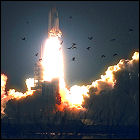 Space Shuttle Atlantis lifts off on the 84th shuttle mission, a ten-day flight with a visit to the Mir space station. Among the supplies hauled to Mir by Atlantis is a new oxygen generator to replace one damaged by a fire aboard the station in February. The crew for Atlantis’ 18th flight is Commander Charles Precourt, Pilot Eileen Collins, mission specialists Michael Foale, Carlos Noriega, Edward Lu, Jean-Francois Clervoy and cosmonaut Elena Kondakova. Foale remains to take up residence on Mir, while American astronaut Jerry Linenger leaves the station to return with the shuttle crew, having spent 132 days in space.
Space Shuttle Atlantis lifts off on the 84th shuttle mission, a ten-day flight with a visit to the Mir space station. Among the supplies hauled to Mir by Atlantis is a new oxygen generator to replace one damaged by a fire aboard the station in February. The crew for Atlantis’ 18th flight is Commander Charles Precourt, Pilot Eileen Collins, mission specialists Michael Foale, Carlos Noriega, Edward Lu, Jean-Francois Clervoy and cosmonaut Elena Kondakova. Foale remains to take up residence on Mir, while American astronaut Jerry Linenger leaves the station to return with the shuttle crew, having spent 132 days in space. During an attempt to manually redock a Progress unmanned supply capsule via remote control from space station Mir, Mir Commander Vasily Tsibliev misjudges Progress’ speed and distance, and the vehicle collides with the station’s Spektr module, breaching that module’s outer skin and allowing decompression to begin. As the hatch to that compartment is sealed off to save the rest of the station (and the crew’s lives), Mir begins tumbling in its orbit, losing power (and all contact with Earth) as its solar panels lose orientation to the sun. With only fleeting opportunities to contact ground controllers, the station’s crew of three has to use the thrusters of the Soyuz vehicle docked at Mir to realign the station and begin receiving solar power again, a process which takes 30 hours; they are unable to use the station’s rest room facility for over 48 hours due to the power loss. The Spektr module is never repaired and it remains sealed off for the remainder of Mir’s time in orbit; makeshift rewiring ensures that the solar panels not damaged in the collision return to service. Most of astronaut Michael Foale’s personal items and experiment data, stored in Spektr, are lost.
During an attempt to manually redock a Progress unmanned supply capsule via remote control from space station Mir, Mir Commander Vasily Tsibliev misjudges Progress’ speed and distance, and the vehicle collides with the station’s Spektr module, breaching that module’s outer skin and allowing decompression to begin. As the hatch to that compartment is sealed off to save the rest of the station (and the crew’s lives), Mir begins tumbling in its orbit, losing power (and all contact with Earth) as its solar panels lose orientation to the sun. With only fleeting opportunities to contact ground controllers, the station’s crew of three has to use the thrusters of the Soyuz vehicle docked at Mir to realign the station and begin receiving solar power again, a process which takes 30 hours; they are unable to use the station’s rest room facility for over 48 hours due to the power loss. The Spektr module is never repaired and it remains sealed off for the remainder of Mir’s time in orbit; makeshift rewiring ensures that the solar panels not damaged in the collision return to service. Most of astronaut Michael Foale’s personal items and experiment data, stored in Spektr, are lost. For the first and only time in the history of the American space program, a previously aborted mission is flown with the same vehicle, cargo and crew. Space Shuttle Columbia returns to orbit with Spacelab in its cargo bay for an attempt to fully carry out the aborted STS-83 mission, which was recalled to Earth in April. This time, the mission is successful, with nearly 16 days of microgravity experiments carried out by the crew. Flying Columbia – again – are Commander James Halsell, Pilot Susan Still, Payload Commander Janice Voss, mission specialists Donald Thomas and Michael Gernhardt, and payload specialists Roger Crouch and Greg Linteris.
For the first and only time in the history of the American space program, a previously aborted mission is flown with the same vehicle, cargo and crew. Space Shuttle Columbia returns to orbit with Spacelab in its cargo bay for an attempt to fully carry out the aborted STS-83 mission, which was recalled to Earth in April. This time, the mission is successful, with nearly 16 days of microgravity experiments carried out by the crew. Flying Columbia – again – are Commander James Halsell, Pilot Susan Still, Payload Commander Janice Voss, mission specialists Donald Thomas and Michael Gernhardt, and payload specialists Roger Crouch and Greg Linteris. Russia launches Soyuz TM-26 on a mission to the Mir space station, which suffered numerous major malfunctions and damage during its previous crew’s stay. Aboard the Soyuz are specially selected cosmonauts Anatoly Solovyev and Pavel Vinogradov, who have trained on the ground to inspect and repair the damage to the station, though they are unable to find the hull damage to the now-abandoned Spektr module which threatened to cause total decompression of the station. They do manage to restore most of Mir’s solar power generating capability during their 197-day stay, returning to Earth in February 1998 with French spationaut Léopold Eyharts.
Russia launches Soyuz TM-26 on a mission to the Mir space station, which suffered numerous major malfunctions and damage during its previous crew’s stay. Aboard the Soyuz are specially selected cosmonauts Anatoly Solovyev and Pavel Vinogradov, who have trained on the ground to inspect and repair the damage to the station, though they are unable to find the hull damage to the now-abandoned Spektr module which threatened to cause total decompression of the station. They do manage to restore most of Mir’s solar power generating capability during their 197-day stay, returning to Earth in February 1998 with French spationaut Léopold Eyharts.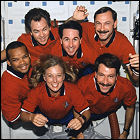 NASA launches Space Shuttle Discovery on the 86th shuttle flight, a 12-day mission to deploy a spectroscopy experiment and practice spacewalking construction techniques vital to the upcoming early missions to build the International Space Station. Aboard Discovery for her 23rd flight are Commander Curtis Brown, Pilot Kent Rominger, mission specialists Jan Davis, Robert Curbeam and Stephen Robinson, and payload specialist Bjarni Tryggvason.
NASA launches Space Shuttle Discovery on the 86th shuttle flight, a 12-day mission to deploy a spectroscopy experiment and practice spacewalking construction techniques vital to the upcoming early missions to build the International Space Station. Aboard Discovery for her 23rd flight are Commander Curtis Brown, Pilot Kent Rominger, mission specialists Jan Davis, Robert Curbeam and Stephen Robinson, and payload specialist Bjarni Tryggvason.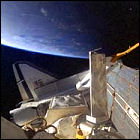 Space Shuttle Atlantis lifts off on an 11-day mission to dock with the Mir space station. In addition to routine supplies, replacement parts are brought to Mir to swap out with equipment damaged during the various incidents and accidents endured by Mir Expedition 23. The first-ever joint American/Russian spacewalk is conducted to undertake some of the repair activity and to try to find the location of the Spektr module hull breach. Aboard Atlantis for her 19th flight are Commander James Wetherbee, Pilot Michael Bloomfield, and mission specialists Vladimar Titov, Scott Parazynski, Jean-Loup Chretien, Wendy Lawrence and David Wolf. Wolf remains on Mir to join the Expedition 24 crew, while Mir crewmember Michael Foale returns to Earth aboard Atlantis, having served 145 unusually eventful days in space.
Space Shuttle Atlantis lifts off on an 11-day mission to dock with the Mir space station. In addition to routine supplies, replacement parts are brought to Mir to swap out with equipment damaged during the various incidents and accidents endured by Mir Expedition 23. The first-ever joint American/Russian spacewalk is conducted to undertake some of the repair activity and to try to find the location of the Spektr module hull breach. Aboard Atlantis for her 19th flight are Commander James Wetherbee, Pilot Michael Bloomfield, and mission specialists Vladimar Titov, Scott Parazynski, Jean-Loup Chretien, Wendy Lawrence and David Wolf. Wolf remains on Mir to join the Expedition 24 crew, while Mir crewmember Michael Foale returns to Earth aboard Atlantis, having served 145 unusually eventful days in space.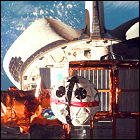 Space Shuttle Columbia lifts off on the 88th shuttle flight, a mission lasting nearly 16 days to conduct microgravity studies and deploy a space science payload which begins spinning after the shuttle’s manipulator arm releases it. Plans to match the shuttle to the satellite’s rotation and recapture it are called off in favor of a no-less-risky seven-hour, two-man spacewalk to slow the satellite’s rotation and retrieve it. Aboard Columbia for her 24th flight are Commander Kevin Kregel, Pilot Steven Lindsey, and mission specialists Winston Scott, Kalpana Chawla, Takao Doi and Leonid Kadenyuk.
Space Shuttle Columbia lifts off on the 88th shuttle flight, a mission lasting nearly 16 days to conduct microgravity studies and deploy a space science payload which begins spinning after the shuttle’s manipulator arm releases it. Plans to match the shuttle to the satellite’s rotation and recapture it are called off in favor of a no-less-risky seven-hour, two-man spacewalk to slow the satellite’s rotation and retrieve it. Aboard Columbia for her 24th flight are Commander Kevin Kregel, Pilot Steven Lindsey, and mission specialists Winston Scott, Kalpana Chawla, Takao Doi and Leonid Kadenyuk.